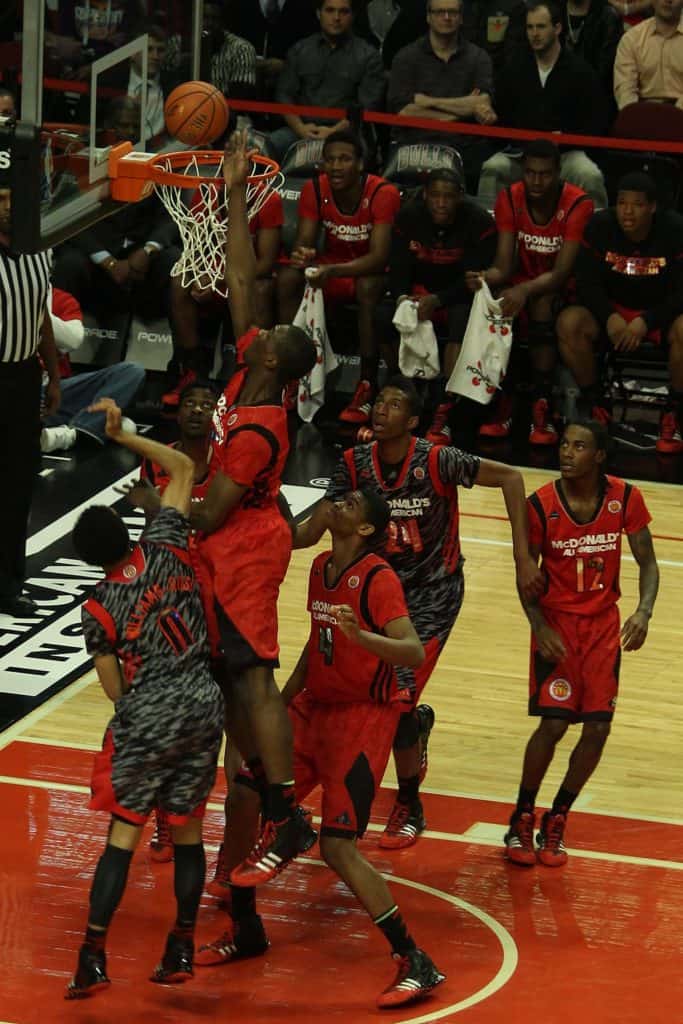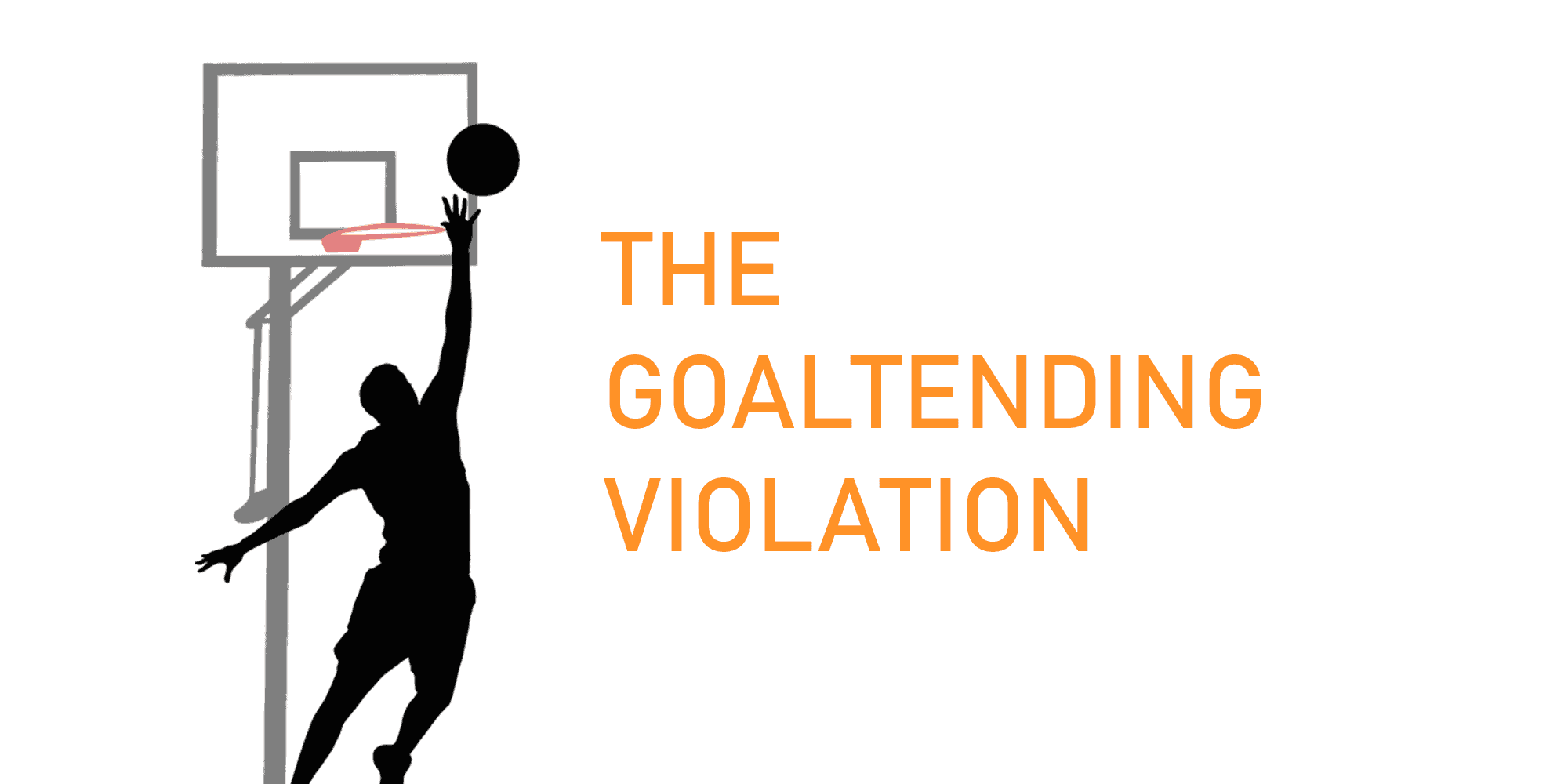It’s almost hard to believe, but at one point in basketball history players could block or prevent any shot from going into the basket no matter where the ball was on its way to the hoop.
A player attempting a 15-foot jump shot could have what looked like a score swatted away at the last minute as it was heading into the basket.
Then, rules changed and the practice, known as goaltending, was prohibited.
The goaltending rule has been adapted through the years but has stayed pretty much the same since its institution in the 1940s.
What is goaltending? What exactly constitutes a goaltending violation? Why was the rule introduced? Let’s answer these questions!

Defining The Goaltending Rule
By definition, goaltending happens during a field goal attempt when one or more players (usually a defending player) interfere with the ball at any time on its way to the basket.
A goaltending violation can only be called under the following conditions:
The bottom of the ball must be above rim level and in a downward flight toward the basket, and be outside the “imaginary cylinder” above the basket. The shot must also have been deliberate, and have a fair chance of going in.
Note: If the ball was inside the imaginary cylinder above the basket, it should instead be ruled basket interference (more on that later).
Put simply, goaltending is called when a defender blocks the ball when it is headed downward into the basket or when a defender touches the ball (which is wholly above rim level).
When a goaltending call is made, the shooting team is awarded the points for the field goal as if they had made the basket.
If the shot attempt was a three-pointer, the shooting team is awarded three points. For a two-point shot, the offensive team is awarded two points and if goaltending was called on a free throw attempt, the shooting team is awarded one point. More on goaltending a free throw later.
After a goaltending call and the shooting team is awarded points, the offending team then inbounds the ball on the baseline just as it would after a made basket.
In the unlikely event that both teams commit a goaltending violation during the same field goal attempt, then no points can be scored and play is resumed by a jump ball at the center circle.
History of Goaltending
The NCAA was first to introduce the goaltending rule and it was primarily due to the play of one individual.
George Mikan was a 6-foot-10-inch athletic center who was able to snatch balls out of the air on their way to the basket.
Because of Mikan’s defensive dominance, the NCAA instituted the goaltending rule in 1944.
The National Basketball League (NBL), the predecessor to the NBA, soon followed by adopting the rule in 1947.
Offensive and Defensive Goaltending
When goaltending was first introduced, the violation was primarily concerned with action on the defensive end. It would take another decade before goaltending on the offensive end would be addressed.
Offensive goaltending occurs when an offensive player touches the ball while it is on a downward trajectory towards the basket and is outside the imaginary cylinder.
It is rare to see offensive goaltending violations, but they do happen, and result in the offending team losing possession of the ball and no points being awarded.
Goaltending Rule Variations
There are some slight differences to the goaltending rule depending upon the level of basketball.
For example, in the NBA, WNBA, and at the NCAA level; goaltending is called on any shot that has already contacted the backboard and is then blocked. Most often, this happens on layup attempts where the ball hits the backboard and then is blocked by a defensive player.
In NCAA and high school basketball, the goaltending rule is a little different when the violation occurs during a free throw attempt. The shooting team is, of course, given the one point and a technical foul is then called on the offending player that committed goaltending.
NCAA goaltending rules vary for men and women. The men’s rule states goaltending occurs when a ball is blocked when it is in a downward flight towards the rim or the ball has been touched while any part of it is in the imaginary cylinder above the rim.
The women’s rule is different in that the ball must be entirely above the basket ring level. Goaltending in women’s college basketball only occurs when the entire ball is at least 10 feet off the ground. In the men’s game, just the top of the ball needs to be at least 10 feet from the ground.
Confusion with Basket Interference
Goaltending is often confused with the basket interference violation. They are fundamentally very similar, but with basket interference, the live ball is (fully or partially) in the imaginary cylinder.
Basket interference occurs in any of the following situations:
- A player touches the ball or any part of the basket while the ball is on the rim
- A player touches the ball while it is in the imaginary cylinder above the rim
- A player reaches up through the basket and touches the ball inside or outside the cylinder
- A player pulls down on the rim or causes the rim to move so that it contacts the ball before returning to its original position during a shot attempt
Like goaltending, when basket interference is called on a defending team, the shooting team is awarded the points for a field goal as if it had been made. When called on a shooting team, no points are awarded and the shooting team gives up possession of the ball.
The one exception to basket interference is when a basketball player dunks the ball. The player may maintain contact with the ball in the cylinder and/or grab the rim momentarily and not be called for a violation.
Offensive goaltending is basket interference though goaltending is the proper call when the ball is on a downward flight to the basket and is outside the imaginary cylinder.
Why Have The Goaltending Rule?
Like other basketball rules such as “double dribble” and personal fouls, goaltending is necessary for making basketball more competitive and more pleasing to spectators. As the popularity of basketball grew in its early days, taller and more athletic players began dominating the game.
The goaltending rule helped to level the playing field so that taller players like Mikan and today’s 7-footers cannot simply swat shots away from the basket at will. It is a violation that makes today’s game much more fun to watch.
Spotting Goaltending and Basketball Interference takes practice!
Understanding the rule in theory is one thing, but actually making the right call is another.
Even basketball officials are known to occasionally make the wrong call, either failing to make a call at all or mixing up basketball interference and goaltending.
If you want to spot these violations reliably, you’ll want to watch a number of instances of calls being made to get a feel for them.

